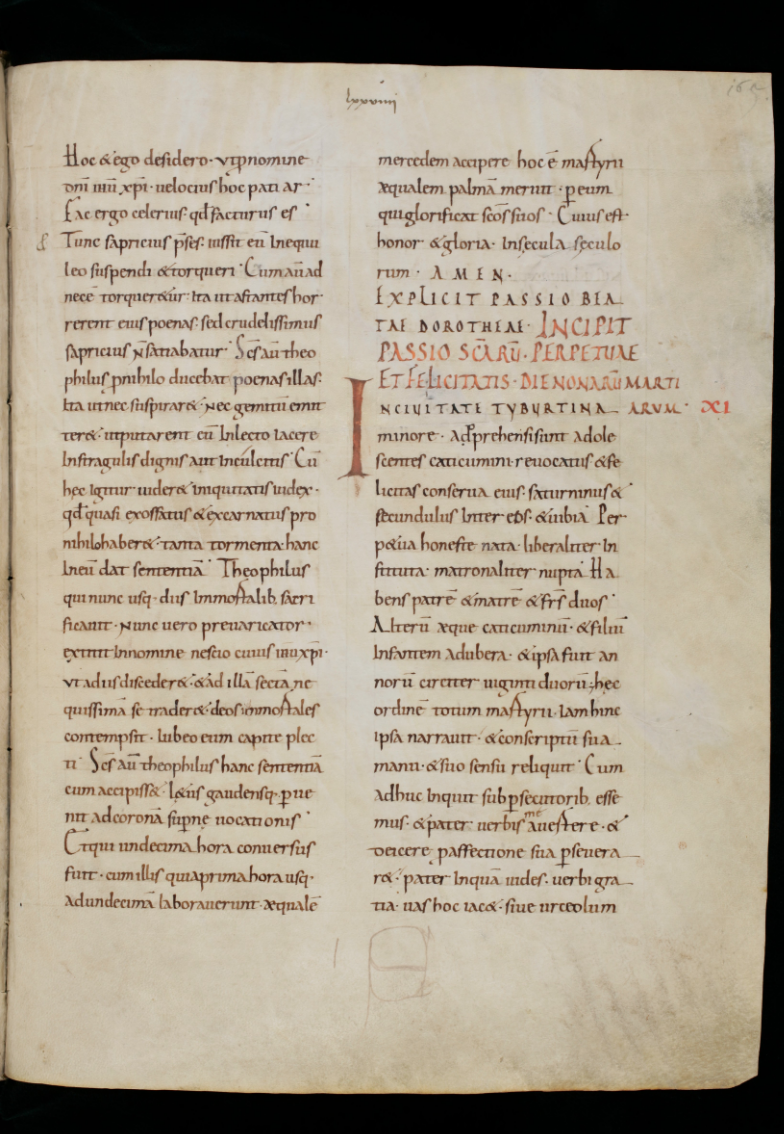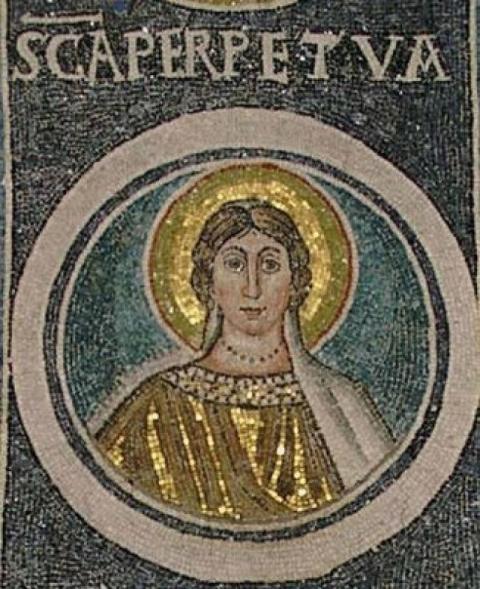Thomas Hendrickson
June 13, 2022
Last year, I published an edition of Perpetua’s Passio together with a group of students: Mia Donato, Carolyn Engargiola, Eli Gendreau-Distler, Elizabeth Hasapis, Jacob Nguyen, Siddharth Pant, Shamika Podila, Anna Riordan, and Oliver Thompson. I worried that a book with ten names in the byline would look like a monstrosity. I worried that, since nine of those names belong to students, people would dismiss it as a school project, of interest only to the parents of the students on the cover. Yet the book has been warmly received: reviewed in journals, adopted for classes, and most recently honored with the 2022 Ladislaus J. Bolchazy Pedagogy Book Award from CAMWS. I say this not to trumpet their work (though I’m certainly proud of it), but rather because I think it speaks to a question that is relevant to the wider scholarly world: what role can students take in academic research and publication?
Students have been taking on responsibilities in a number of large digital endeavors, like the Homer Multitext Project. As teachers and scholars, we should be on the lookout for other ways to give students the opportunity to contribute to the world of research. It gives students a chance to see that there are conversations happening in the world of academia, and that they can have a voice in those conversations. After all, not all scholarly work requires a Ph.D. In the case of making a student edition of a Latin text, the main labor was drawing up a glossary for the text and writing a commentary that explains the basic grammar: this is work that students can do, especially with appropriate scaffolding.
For our edition, which we made as part of an advanced Latin course, I divided the Latin text of the Passio into nine parts and had each student serve as section editor for their portion of the text: adding in the correct macrons, creating a glossary, and writing a commentary. After each stage there was peer review, and I did a final revision for the whole. Then I wrote the volume introduction, which the students reviewed and revised in turn.
To give some perspective on the student experience of a project like this, I spoke with two students, Eli Gendreau-Distler (a senior at Stanford Online High School) and Siddhant Karmali (a junior at Stanford Online High School). Eli is one of the co-authors of the Perpetua edition (which is free online here), and Siddhant is a co-author for a new edition of Isotta Nogarola, which he has just completed together with Finn Boyle, Siria Chapman, Dhru Goud, Kennedy Leininger, Justine Stern, and Amelie Wilson-Bivera:

Figure 1: Opening page of The Passion of Saints Perpetua and Felicity in St. Gallen, Stiftsbibliothek. Image courtesy of Wikimedia Commons.
Thomas Hendrickson: How were these projects different from a typical advanced Latin class (where you read a text, translate it in class, and take an exam on it)?
Eli Gendreau-Distler: For me, the most significant difference between this project and previous, more traditional Latin classes was that I kept returning to the same section of the text for each stage of the project rather than reading each section only once before moving on. This enabled me to develop a much deeper understanding of my portion of the text than I otherwise would have. In addition, this project not only required me to understand the grammar and meaning of the Latin text, as in typical Latin classes, but also to consider the most effective ways to present the text to first-time readers.
Siddhant Karmali: Doing the book project differed from a conventional Latin class because the material we were covering had not been widely studied before, like Vergil’s Aeneid. Our group worked together to review, macronize, translate, and make a commentary on Isotta Nogarola’s Defense of Eve. We collaborated with each other in this class more so than if we were to have a conventional class.
TH: What did you learn from the project?
EGD: Because this project involved repeatedly revisiting the same section of the Latin text, I had expected that I would develop a more or less complete understanding of the grammar and meaning of my section after the first few phases of the project. I was surprised and excited to discover that I learned something new about the Latin text each time I returned to it. This helped me appreciate the layers of meaning that can lie hidden within a Latin text and the benefits of approaching a text multiple times through different lenses.
SK: This project made me able to look more closely at what confuses me in [a] Latin text, which I found hard to do before this project. I also was able to think more deeply about why a certain construction or quotation was used. In an English class, we are taught to use literary analysis skills to explain the author’s arguments. We quickly improve in this respect, since English is our mother tongue. However, doing this in Latin gave me a new perspective on how I analyze works of literature. From this project, I learned that, to be able to accurately analyze a work of Latin literature, one must be able to think through individual words within the greater context [of] the work.
TH: What was hardest about the project?
SK: Writing the one-page commentary was harder than writing the glossary and checking the macrons, since it took more time and effort to understand the words in context and then explain them accurately. The helpful class environment aided with this, since I was not punished for making mistakes. I enjoyed the thrill of translating unknown Latin, since I could understand it better by making mistakes and then improving.
EGD: I think the hardest aspect of the project was identifying the parts of the text that first-time readers would find challenging or confusing after I had read the text several times. Once I became familiar with the text, it was easy to lose sight of the things that tripped me up the first time through. This project helped me gain a new appreciation for the work that goes into distinguishing information that students will find helpful from information that students will find distracting in Latin student editions more broadly.
TH: Can you think of a specific example of a problem and how you overcame it?
EGD: I spent a considerable amount of time on a commentary entry explaining the historical context for a reference to Geta Caesar. I think I got a little carried away with details that were interesting but not particularly relevant, and getting a classmate’s perspective during peer review was helpful for cutting back on unnecessary information. More generally, some strategies I used for determining what sort of vocabulary and commentary entries first-time readers would find useful included looking back at my notes and preliminary translations from the first few times I read the text, and taking note of what my classmates had trouble with when we discussed the translation in class.
SK: The line sī Deus eam appārenter nōn redēmit was confusing to me because the appārenter threw me off. I asked for help, and I was able to take out the appārenter and add it in after I had translated the rest. So, it basically translates to "if God seems to have not redeemed her (it was in appearances only)." I overcame this problem, and many more, by asking for help from both my co-collaborators and Magister Hendrickson.
TH: What is your proudest accomplishment in the book?
EGD: I am most proud of the collaboration and peer-review process that went into producing the best book we possibly could. At the beginning of the process, I was a bit nervous for the peer-review stages, because it can be difficult to give and take significant feedback without worrying about hurting feeling or minimizing the work of others. I think we all quickly came to view the peer-review process as an opportunity for constructive discussion and collaboration rather than critique, which made it feel more comfortable and productive than I had anticipated.
SK: There is no [single] proudest accomplishment, but…translating a large section of text that didn’t already have a commentary — I feel like that’s a pretty big accomplishment.
.jpeg)
Figure 2: The martyrdom of Perpetua, Felicitas, Revocatus, Saturninus and Secundulus, from the Menologion of Basil II (c. 1000 AD). Image courtesy of Wikimedia Commons.
A few final reflections from TH:
From a teacher’s perspective, I was struck by how the students took control of their own learning when given the opportunity for real academic responsibility (being an editor for a portion of the text) and real credit (all names on the cover). In taking on responsibility for editing a portion of the text, they took responsibility for learning whatever they needed in order to do that — and it is a responsibility they seized eagerly. I have no doubt that students learned more doing these projects than in the more traditional classes I’ve taught, and I suspect it is because they could feel a sense of ownership over their own intellectual work. They weren’t working for me or for a test, but for themselves.
Not everything went easily or smoothly. There were logistical hurdles to publishing, particularly because we were self-publishing with a print-on-demand service — it was up to us, for instance, to care for myriad minor formatting issues. The students also found that scholarly work can sometimes be tedious, like when we had to go through and check all of our macrons. Finally, everything about the book took a good deal of time: it took far longer to write this book as a group than it would have taken if I were simply working on my own.
Yet from a scholar’s perspective, I would emphasize that the end product was better than I could have made on my own precisely because the students were bringing their own perspectives to bear. In our Perpetua edition, for instance, some students in the class held very traditional Christian views, while others were completely unfamiliar with Christianity: our edition was clearer and more inclusive for having to make sense to both kinds of reader. Some students thought that we were pushing too hard to make Perpetua relevant to modern progressive sensibilities, others thought we were underplaying how radical she was: our debates forced us to keep our interpretations close to the text. Toward the end of the project, I wrote the volume’s introduction, which the students revised and edited, and they changed my mind about something significant on just about every page. Collaborating with students does not speed academic work (quite the opposite), but it does create a stronger final product.
For those interested in the technical details of how we made the edition, there is an article forthcoming in Teaching Classical Languages co-authored by myself, Anna Pisarello, and John Lanier. We three are the editors of a new series of open-access student editions of Latin texts written by women. The first two volumes (The Passion of Perpetua and Isotta Nogarola’s Defense of Eve) are out now.
Header image: Mosaic of Saint Perpetua, Croatia. Image courtesy of Wikimedia Commons.
Authors


